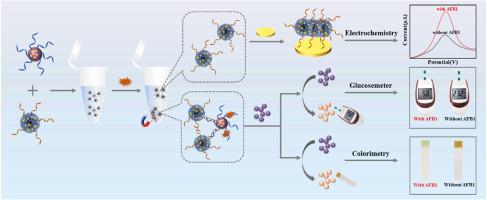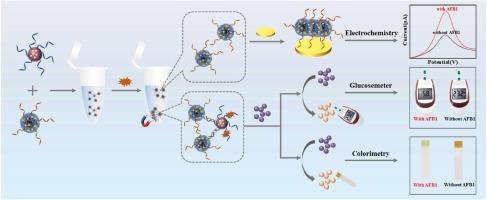Electrochemistry–glucosemeter–smartphone integrated multi-mode biosensor for accurate detection of aflatoxin B1
IF 5.7
2区 化学
Q1 CHEMISTRY, ANALYTICAL
引用次数: 0
Abstract
Background
Aflatoxin B1 (AFB1) is a widely distributed toxic contaminant in food and poses a serious threat to public health. Therefore, an accurate, simple, cost-effective and on-site assay method is needed for sensitive detection of AFB1. Aptamer shows great potential in the construction of biosensor due to its high specificity and affinity. Multimodal biosensor based on aptamer is highly suitable for the analysis of AFB1 under complex conditions. And the detection results in different modes can be verified with each other, which greatly improves the accuracy of AFB1 detection.
Results
Herein, accurate detection of AFB1 was achieved through the development of a multi-mode biosensor integrating electrochemistry, glucosemeter and smartphone-based colorimetric quantification. Streptavidin-Cu3(PO4)2 hybrid nanoflowers (SA-Cu3(PO4)2 HNFs) were synthesised and then conjugated with biotinylated invertase as a signal probe. The electrochemical signal was achieved via intrinsic redox activity. Simultaneously, sucrose could be converted to glucose by the action of invertase, which can cause changes in the glucosemeter signal as well as in the colour of urine glucose test strips. The glucosemeter could complete the signal response in 7 s, and the urine glucose test strips could complete the colour development in 30 s. The detection range of AFB1 by this system in electrochemical mode is 0.001–100 ng/mL, and in glucosemeter mode and smartphone mode is 0.01–50 ng/mL. The limits of detection were 0.49 pg/mL in electrochemistry mode, 5.4 pg/mL in glucosemeter mode and 3.7 pg/mL in smartphone mode.
Significance
The successful construction of this multi-mode biosensor demonstrates the advantages of multifunctional nanomaterials and mobile technology. Rapid and accurate detection of AFB1 is achieved through the integration of electrochemistry, glucosemeter and smartphone-based colorimetric quantification. And this biosensor provides a novel detection platform that combines sensitivity, accuracy, affordability and portability for rapid on-site food safety screening.


用于准确检测黄曲霉毒素 B1 的电化学-葡萄糖计-智能手机集成多模式生物传感器
背景黄曲霉毒素 B1(AFB1)是一种广泛存在于食品中的有毒污染物,对公众健康构成严重威胁。因此,需要一种准确、简单、经济、现场检测的方法来灵敏检测 AFB1。由于具有高特异性和亲和性,色聚体在构建生物传感器方面显示出巨大的潜力。基于适配体的多模式生物传感器非常适合在复杂条件下分析 AFB1。结果通过开发集电化学、葡萄糖计和基于智能手机的比色定量于一体的多模式生物传感器,实现了对 AFB1 的精确检测。研究人员合成了链霉亲和素-Cu3(PO4)2 杂交纳米流体(SA-Cu3(PO4)2 HNFs),然后将其与生物素化的转化酶共轭,作为信号探针。电化学信号是通过内在氧化还原活性实现的。与此同时,蔗糖可在转化酶的作用下转化为葡萄糖,从而导致血糖仪信号和尿糖试纸颜色的变化。该系统在电化学模式下对 AFB1 的检测范围为 0.001-100ng/mL ,在葡萄糖计模式和智能手机模式下为 0.01-50 ng/mL。该多模式生物传感器的成功构建展示了多功能纳米材料和移动技术的优势。通过整合电化学、葡萄糖计和基于智能手机的比色定量技术,实现了对 AFB1 的快速准确检测。这种生物传感器提供了一种集灵敏度、准确性、经济性和便携性于一体的新型检测平台,可用于现场食品安全快速筛查。
本文章由计算机程序翻译,如有差异,请以英文原文为准。
求助全文
约1分钟内获得全文
求助全文
来源期刊

Analytica Chimica Acta
化学-分析化学
CiteScore
10.40
自引率
6.50%
发文量
1081
审稿时长
38 days
期刊介绍:
Analytica Chimica Acta has an open access mirror journal Analytica Chimica Acta: X, sharing the same aims and scope, editorial team, submission system and rigorous peer review.
Analytica Chimica Acta provides a forum for the rapid publication of original research, and critical, comprehensive reviews dealing with all aspects of fundamental and applied modern analytical chemistry. The journal welcomes the submission of research papers which report studies concerning the development of new and significant analytical methodologies. In determining the suitability of submitted articles for publication, particular scrutiny will be placed on the degree of novelty and impact of the research and the extent to which it adds to the existing body of knowledge in analytical chemistry.
 求助内容:
求助内容: 应助结果提醒方式:
应助结果提醒方式:


